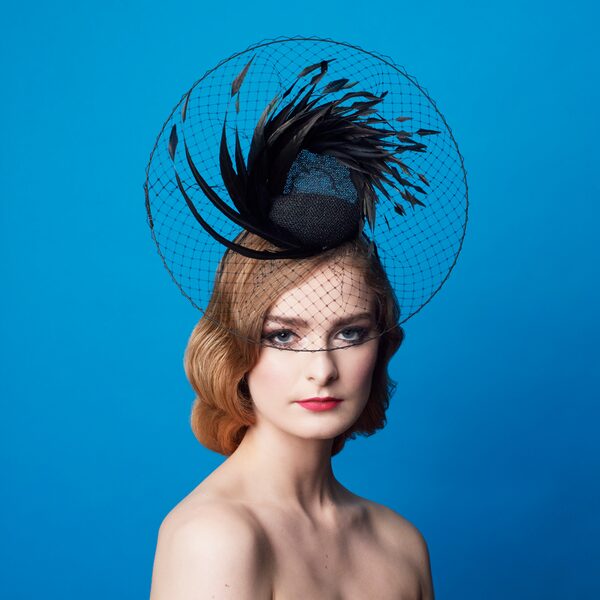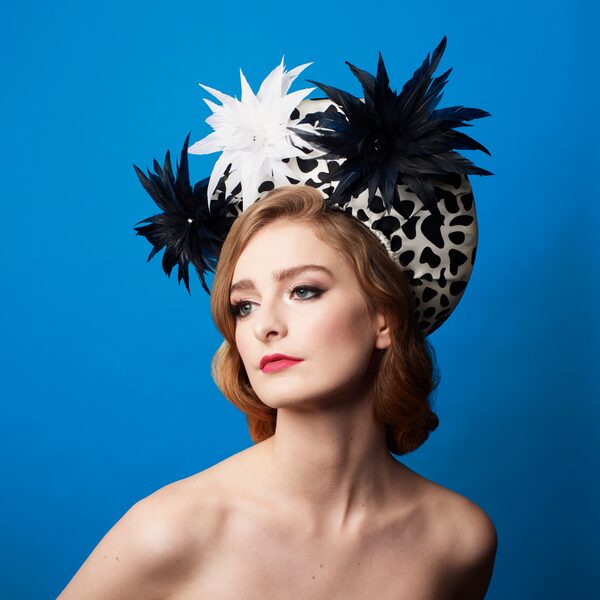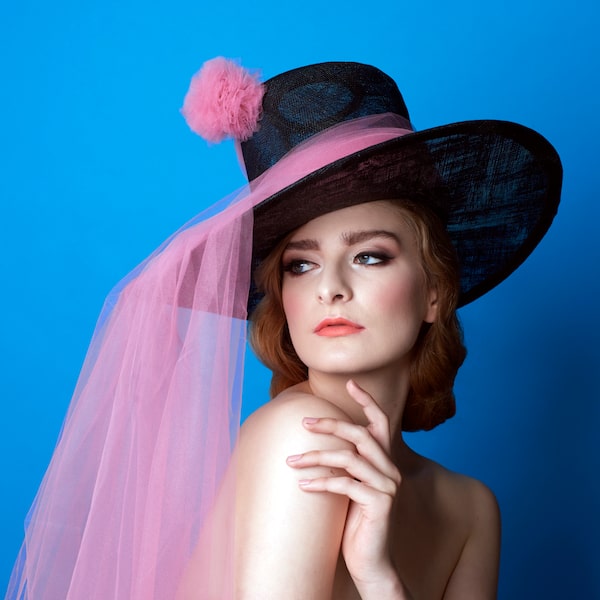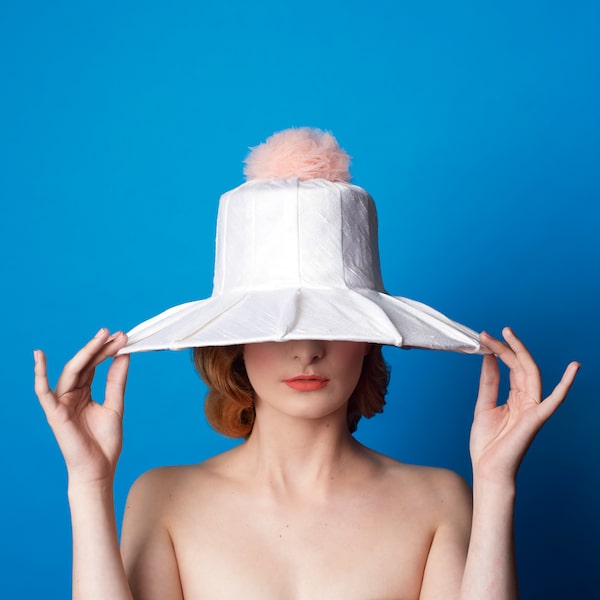
David Dunkley, official milliner of the Queen’s Plate in Toronto, has a special new collection of Queen’s Plate-themed hats photographed for the occasion.Kristina Laukkanen/David Dunkley Fine Millinery
Towering tulle confections and sharp saucers trimmed with quivering feathers dot the stands as spectators, preening in their elaborate outfits, sip cocktails, place bets and cheer the passing thoroughbreds. It’s just another day at the races. It could be 1909, except for the constant posing and Instagram posting.
Cue the usual eye roll and heavy sigh about millennials and their selfies, right? Wrong. Generations – not just that one – have become smitten with the idea of dressing up again for a day at the races and it has more going for it than the hollow photo op of pop-ups such as the Museum of Ice Cream and Happy Place. The peacocking derby days, as I’ve come to call them, are as much about creating a sense of occasion as they are a canny promotional strategy to renew interest in the sport of horse racing itself.
In recent years, Canadian racing events have steadily cultivated a new audience with marquee derby days. The host organizations have looked to similar throwback dress-up events that have become phenomena, such as the annual Jazz Age Lawn Party on Governors Island in New York Harbor (its Bathing Beauties and Beaus fashion promenade is a highlight). How many other regular opportunities are there besides weddings, really, for the average person to have fun with the elevated, madcap or vintage glamour of what’s now become anachronistic dress-up?
In the West, the annual Deighton Cup held at Vancouver’s Hastings Racecourse and Casino has been a highlight of the summer season since it launched a decade ago, and attendance has swelled. When it first launched, a few hundred people attended; in 2018 the revellers numbered more than 7,000. The producers expanded east last year, inaugurating a sister event at Toronto’s Woodbine Racetrack called the Greenwood Stakes. Vancouver’s daytime derby in July is a parade of fashion and even formalizes the one-upmanship with a Style Stakes competition that awards his and hers best-dressed ribbons for Gallant Sartorialist and Belle du Jour. Similar style competitions have helped attract more women to the events, as well as major brand sponsors in cocktail and other lifestyle categories.
‘Black Drag Queens Invented Camp’: Why we need this history lesson
Designer Sophie Theallet on the perils of mixing politics and style
Why the new look of womenswear is big, poufy – and powerful

There's an awareness of millinery more than ever before, Dunkley says, particularly with people between the ages of 20 and 35.Kristina Laukkanen/David Dunkley Fine Millinery
The continuing fascination with all things royal – two royal weddings last year, another last month – certainly contributes to the revival, says designer David Dunkley, official milliner of the Queen’s Plate in Toronto. Horse racing is known as the sport of kings, after all. “Society people always wear hats, but it comes in and out of mainstream fashion. And then you have the royal wedding in 2011 – the whole game changed,” he says.
More than ever before, there is an awareness of millinery, Dunkley says, particularly with younger people between the ages of 20 and 35. “The thought of putting something on their head isn’t foreign any more,” he says. For Dunkley, the style revival is also happening in tandem with an interest in good manners and codified etiquette. “I’m often educating people,” Dunkley says of bygone social graces, such as when a man should remove or doff his hat, or the hour after which women should switch from a hat to a fascinator or cocktail hat (sunset, or 6 p.m.).
Dunkley practises traditional fine millinery so everything, from the entry-level headpieces and the custom-dyed silk swirl of his popular Royal Rose hat, is crafted in-house and by hand. He even peels, cuts and shapes his own feathers. This season Dunkley is having a run on feathers. “People love the movement, the texture; feathers are still politically correct, whereas fur is not, so people love the luxury.”

Dunkley practises traditional fine millinery so everything is crafted in-house and by hand.Kristina Laukkanen/David Dunkley Fine Millinery
Canadian entertainment blogger Will Wong has loved Hollywood almost as long as he’s loved horses, so he’s delighted with the attention big race days such as the Kentucky Derby and the Queen’s Plate are getting. For him, the hobby dates back to his childhood, when even in high school he’d take the bus to the racetrack after school (his parents first brought him to the races at the age of three). “You follow the stories of the horses and become invested in them,” Wong says, pointing out that, compared to his youth, the grandstands are more diverse and class-inclusive than before. “To be a part of something that historically was so closed, it’s like having high tea at the Royal York [Hotel]. It’s like, Oh I can do it too!” In Vancouver, for example, a $65 festival ticket for the Deighton Cup is more accessible than the charity garden parties and gala-dinner prices of the society circuit, and at the Queen’s Plate at Woodbine, even the $25 general admission includes access to the fashion-focused Hats and Horseshoes Party and its red-carpet photo op.
Wong knows his way around both the back stretch and celebrity culture, and finds the new influencer culture and the horse-racing community to be natural allies, since racing has become more internet-based and social-media savvy than other sports by necessity – the mainstream media don’t regularly cover racing as a sport the way they once did. “Racing has gone online, not just the betting but coverage of results, so the social component becomes more important,” Wong says.
Not that snapping it for the ’gram isn’t part of the appeal. “Some people have their entrance hat, a red-carpet piece,” Dunkley explains. Take the centrepiece of his new Queen’s Plate collection: an elaborate towering headpiece covered in more than 300 tulle pompons. They riff on the fashion theme the event is promoting this year, chrysanthemums and daisies that represent the flowers typical of a horse wreath. It’s similar to something Gemma Chan wore to the Met Gala, based on a showstopper that Alexandre de Paris concocted for Elizabeth Taylor in the 1960s. Its trim riding-hat counterpart is modest by comparison and is “the one they wear inside,” Dunkley says. And although his taste is classic design, Dunkley also dabbles in the Instagram and society-page catnip that he calls couture kitsch, such as a headpiece mounted with giant googly eyes or whimsical sprouting daisies and an asymmetrical polka-dot cocktail hat worthy of peak Joan Crawford. “I think everybody on Instagram just wants to see fantasy, so the stuff that gets the most likes and interest is the fantasy pieces,” he says of showstoppers and conversation-piece hats.

Of showstoppers and conversation-piece hats, Dunkley says hats that get the most likes and interest on Instagram are fantasy pieces.Kristina Laukkanen/David Dunkley Fine Millinery
Beyond the gin and tonic stations and elaborately decorated step-and-repeat flower walls that make for killer Instagram backdrops, “racing is very much about the stars of the sport – the horses,” Wong says, and now is the time to capitalize on the excitement in the field. In the past decade, there have been two Triple Crown winners, for example. “It took 40 years for that to happen! And that’s revived interest. Playing up the fashion and socializing aspect is a good thing,” Wong says, for connecting the sport to a younger generation.
Look at Australia, he adds: “Now, the racetrack is the place to be, meet and have drinks on the weekend. In Canada, the Queen’s Plate is the pinnacle, their one day to get people to come out. Whether they come back or not, who knows?”
After a couple of Royal Flush cocktails, I’d probably take that bet.
Live with style. We have a weekly Style newsletter on fashion and design trends, plus shopping tips and inspiration. Sign up today.